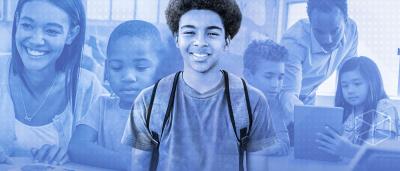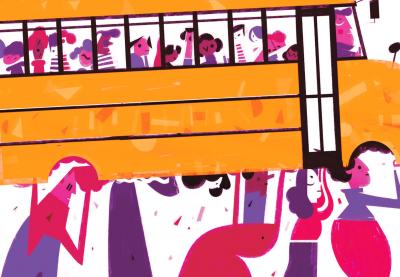In the fall of 2013, 50.1 million students enrolled in U.S. public elementary and secondary schools—schools operated under a system that officially claims to offer a free and equitable education. But what many of those students and their families (not to mention their teachers) know is that public education is neither.
Over the years, activists in both the public and private sectors have acknowledged and attempted to bridge the education equity divide. President Lyndon B. Johnson signed the original Elementary and Secondary Education Act in 1965 as part of his War on Poverty. The law took aim at the educational deprivations that accompanied poverty. Although it pumped federal dollars into the nation’s poorest schools, the act couldn’t entirely erase the inequities inherent in an education system that relies on local funding.
Today, public schools across the per-pupil-spending spectrum routinely turn to parents and community members to supplement public money through donations and fundraising, a practice that magnifies the spending gap and amounts to de facto privatization. Socio-economic disparities among districts mean that some communities have more to give—both through public funding and private giving. Communities with fewer financial resources (and in much greater need) watch the gap grow wider.
“The common-school dream of Horace Mann, which was fully funded public schools, is eroding,” says Jonathan Zimmerman, a professor of history and education at New York University. “It’s very much of a piece with what all the economists are calling the dominant economic trend of our own time, which is a widening of American inequality. … This creates yet another avenue to separate and divide the haves from the have-nots.”
Consider the circumstances of two public institutions. One is a school in rural North Carolina, where teachers hatched fundraising ideas and hoped this would be the year to establish a parent-teacher organization to meet basic classroom needs. The other is a New York school that requested parents write a check for $1,300 to subsidize per-pupil spending for the year. These cases illustrate a clear correlation identified by the Federal Education Budget Project between the primary funding source and equitable education: The more localized the school funding, the greater the inequity.
Different Districts, Different Worlds
The pattern plays out in the Lake Oswego School District outside Portland, Ore., as well. Lake Oswego is a district with means. The surrounding population is well-off: Oregon Department of Education figures show that only 12 percent of Lake Oswego students qualified for free and reduced lunch in the 2012-2013 school year, well below the state average of 54 percent. The district boasts a school foundation that raised $1.7 million in 2013 specifically for the hiring of new teachers, and a parent organization that raises funds for technology and supplemental classroom upgrades.
“We enjoy the benefit of the teachers [the foundation] hires,” says Gerrit Koepping, a social studies teacher at Lake Oswego High School. “It lowers class size a little bit, it adds a couple electives.” The parent association recently raised funds for a new foreign-language listening lab and provides Koepping with as much as $600 a year for research texts for the constitutional law team.
About two hours south of Lake Oswego, teachers in the South Lane School District can only dream of the sort of funding support Koepping enjoys. The district, which is rural, educates kids from a community that is struggling to recover from the decline of the timber industry. Sixty-seven percent of South Lane students qualify for free and reduced lunch.
Individuals and companies with the means to help are overrun by all the district programs that need money, says Erin Royse, a teacher of art and physical education at South Lane’s Cottage Grove High School.
“There are amazing businesses here that do give and give and give,” she says. “But you feel bad because you can’t go past FBLA [Future Business Leaders of America], and then GSA [Gay Straight Alliance], then the Spanish Club, then the football team and the soccer team—they all go hit up the same businesses. You’re really limited … because we can’t deplete our resources here.”
Royse temporarily lost her job several years ago, until the district could cobble together enough money to bring her back. “It’s like standing on one leg in a windstorm,” she says. “When there’s an economic shortfall … you’re kind of wobbling all over the place. It makes it difficult to level out education and put priorities where they should be.”
Funding Matters
Student success is dependent in part on funding—how much and what kind. A recent study by Education Week and Advance Illinois found that a higher level of spending per student correlated with improved fourth-grade National Assessment of Educational Progress (NAEP) reading results. The study also found that it wasn’t funding level alone that mattered: NAEP scores were higher when a greater percentage of funding came from the state. Also, scores for all students increased when funding was more equitably distributed.
A Bourgeoning Fundraising Industry
In the face of budget shrinkage and limited community resources, fundraising efforts have gone far beyond occasional bake sales and car washes. Commercial sales of magazines and candy, auctions, per-plate dinners, commercial partnerships, Internet campaigns and direct requests for parents to write checks are becoming commonplace.
“Fundraising now starts with a direct ask at the beginning of the year. Write a check for $250 or so and opt out of selling candy and everything else guilt-free,” says Lisa Davis, a former parent-teacher organization (PTO) board member and parent council representative in her northern California district. “So—is this equitable? Absolutely not. Our students have things other schools do not. Schools with more have things we do not.”
An example of a school with less is James W. Smith Elementary in Craven County, N.C. Smith students, for example, pieced together $500 by selling buttons—but that money didn’t go far once it was spread across the art, physical education and music departments. “We are just making ends meet,” says Elizabeth Cox, the music teacher at Smith.
So when Cox realized she needed to replace her classroom’s glockenspiel and xylophone mallets, she went digital and broadened her audience through DonorsChoose.org, an online crowd-funding program. Cox secured the $350 she was seeking through a hodgepodge of donations from out-of-state family and friends, other teachers and one generous anonymous donor.
As of March 2014, DonorsChoose.org had funded more than 437,000 projects and raised $230 million via the support of 1.3 million users. The list of similar online services is dizzying: Adopt-A-Classroom, Digital Wish, JustGive, Supply Our Schools, GoFundMe, FirstGiving, FundRazr and Razoo are among the most popular.
More traditional fundraising sales of goods, such as wrapping paper and magazines, remain standard in U.S. schools today—there are just more of them. Ann Garvin, the mother of two teenage girls, feels like a turnstile for for-profit commercial fundraisers. “I have cheese, cheesecakes, popcorn, wrapping paper, coffee, cookie dough and local business punch cards amounting to two or three hundred dollars in my house right now,” she says.
But the payoff is often disappointing. Few of Garvin’s hundreds of dollars in purchases likely went to the school. Because of the limited effort-to-dollar rate of return, low-income and rural schools like Morrison Elementary in southeast Ohio are less likely to sign up for sales programs, but many embrace opportunities like General Mills’ “Box Tops for Education” loyalty program.
Box Tops, through which schools receive 10 cents per box top collected, works with more than 90,000 registered elementary and junior high schools. In 2012, the Box Tops program made $73 million in school donations—a significant increase from the $33 million donated in 2007.
A close look at Morrison Elementary’s recent Box Tops activity, however, reflects an economically challenged community. The program earned the school $2,221 in 2009-2010 and $1,087 in 2011-2012; the returns are projected to be even smaller this year. Family budgets are tight. While national box-top clipping programs have skyrocketed since the recession, such commercial programs primarily benefit communities whose residents can afford to purchase name-brand products, not those who live in underprivileged areas.
The Bottom Line
“The Economy’s Impact on Back to School” report, published by GreatSchools and Harris Interactive, indicates that parent volunteerism at schools has increased by 20 percent since the recession, and 64 percent of parents say that volunteering at their children’s schools is more important than ever.
Family and community involvement in schools can be a benefit for children and can help foster local investment in educational opportunities. But while the power-parent, community-funded schooling experience is the norm today, many schools simply cannot rely on this model, and shouldn’t have to. With about 50 million Americans living beneath the poverty line, the funds just aren’t there to raise.
Some districts have taken steps to address intradistrict inequity caused by school-based commercial fundraising and foundations. For example, the Santa Monica-Malibu Unified School District has banned both PTOs and foundations from contributing directly to a particular school to pay for salaries or programs. Instead, fundraising proceeds are distributed equally among the district’s schools. But these Band-Aid efforts don’t address funding inequities between rich and poor counties and states. The bottom line: Until we ensure that all schools receive adequate funding, our education system will remain fundamentally inequitable.
Informed and vocal education advocates have the greatest potential for positively affecting the system. Funding inequities have plagued the U.S. public school system from the early days of “rate bills”—parental fees that funded schools based on what communities could afford. It was only through efforts of reformers called “common school crusaders” in the mid-1800s that rate bills were slowly abolished state by state.
Activists in 2014 don’t have a focus as specific as the rate bills, but the social injustices facing today’s students represent a troubling historical regression. For NYU’s Zimmerman, the takeaway is that an inequitable system means some students are deprived of an adequate education.
“I’m in no way begrudging the fact that the principal or the superintendent is going hat in hand to the citizenry,” says Zimmerman. “What I am begrudging is the fact that they’re forced to do so.”

